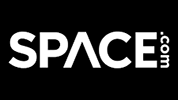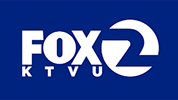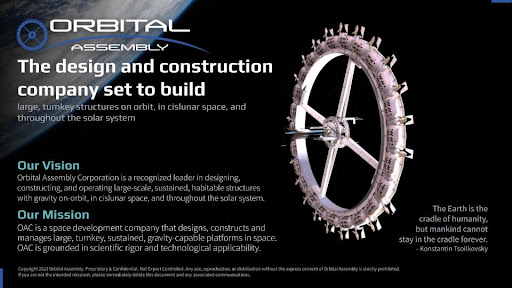Introduction
OAC aims to fulfill the dream of low-gravity space habitation for all.
OAC is working towards becoming one of the world’s most extensive space development companies, and a leader in industrial space development. We are striving to enable humanity with the ability to work, play and thrive in the space ecosystem. The company has developed the technology and capabilities to build structures in space at an exponentially lower cost than to build them on Earth and transport them.
The company designs and plans to construct large, gravity-equipped platforms, with on-orbit services projected to begin in 2023. OAC is focused on low Earth orbit design, construction, and operation of large-scale, habitable structures. We believe that for the first time, space tourists and other inhabitants will be able to experience long periods in space without the debilitating long-term effects of zero gravity.
Vision:
OAC is designing, constructing, and operating large-scale, sustained, habitable structures with gravity on-orbit, in cislunar space, and throughout the solar system.
Mission:
OAC is a space development company that designs, and plans to construct and manage large, turnkey, sustained, gravity-capable platforms in space. OAC is grounded in scientific rigor and technological applicability.
We anticipate our services for our habitable stations will include:
- Long Duration Missions,
- Space Tourism,
- Astronaut crew training facilities,
- Manufacturing,
- Leasable space,
- Research and development,
- Media and film production,
- Branding and sponsorship opportunities.
Our detailed business plan forecasts being cash flow positive by 2025.
Deal Highlights
- Commercialization of space is accelerating. Investing in OAC is investing in early space industry development.
- The Future Is In Rotation.™ OAC aims to create large scale artificial gravity space stations. Other industry players are focused on the resources of times past, with designs to recreate the same microgravity platforms that have been used for the last 48 years.
- We believe OAC is positioned to take advantage of, and dominate, a market that is projected to be worth $60 billion per year within a few years.
- OAC is tapping into a massive space tourism market that has been repressed by high launch costs for the last 60 years. OAC aims to provide a comfortable and healthy environment using a modular approach at scale, and we believe we will be able to offer unparalleled luxury accomodations at a much lower cost compared to other commercial stations.
Problem
Humanity’s 70 years of advancing space development has been hindered because astronauts on orbit begin feeling the detrimental effects of microgravity within 48 hours. Until now, long term sustained habitation on orbit has not been possible. OAC provides for the critical need of artificial gravity by providing critical infrastructure solutions enabling construction, maintenance, research, commerce, and other operations on-orbit for long periods of time without the detrimental health effects of microgravity.
OAC stands apart from its competitors by working towards providing destinations for all humanity.
OAC has forever changed the paradigm of “inevitable dependency” on both a microgravity and a human workforce for large-scale assembly through the utilization of robotic systems to build rotating structures at scale. With OAC’s innovative and proprietary designs, we have enabled building large structures without a large on orbit workforce, fast tracking the construction of gravity capable platforms in a way that has previously not been possible. It is this automated system of assembly that makes space available to everyone.
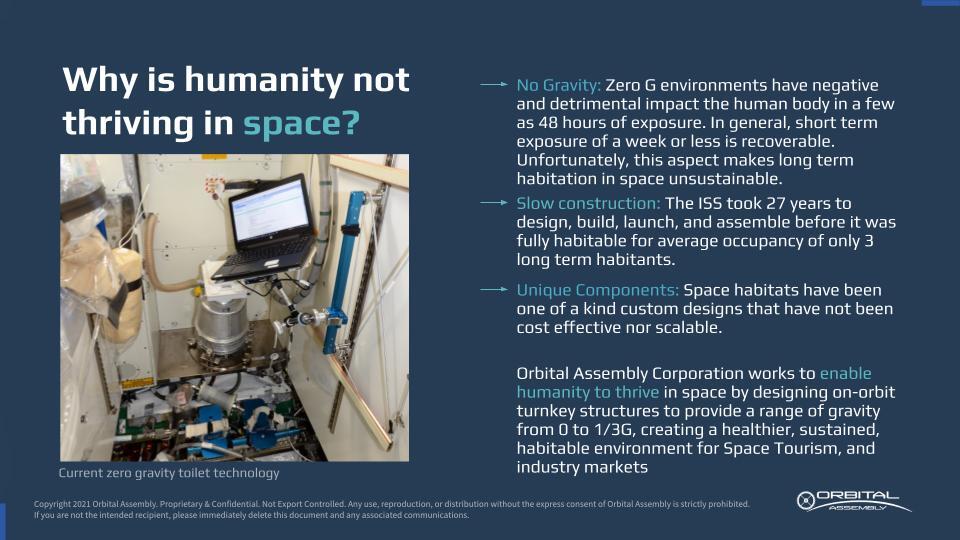
Solution
Our future in rotation begins with the PSTAR™ and Gravity Ring™ mission, scheduled to launch in 2023. We are building the Pioneer Class™ (due 2025) and Voyager Class™ (due 2027) space stations, with artificial gravity, allowing for a permanent in-space workforce to build and maintain large space structures in a habitable environment. Our proprietary construction methods and patented components employ semi-autonomous and teleoperated robots. Our stations are being designed to provide opportunities to space tourists, commercial companies, researchers, and governments to access space. Our designs, robotic systems, and processes build a wide variety of large on-orbit platforms providing artificial gravity.
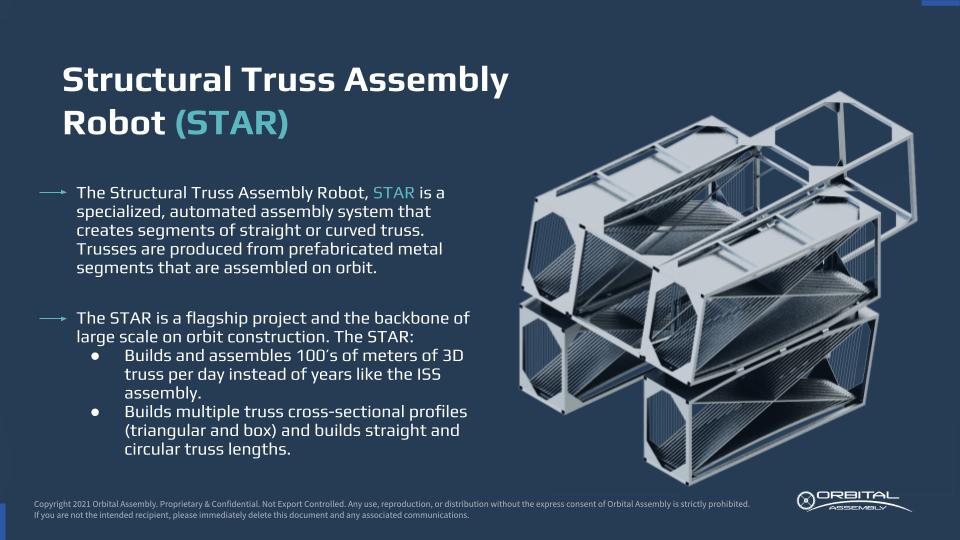
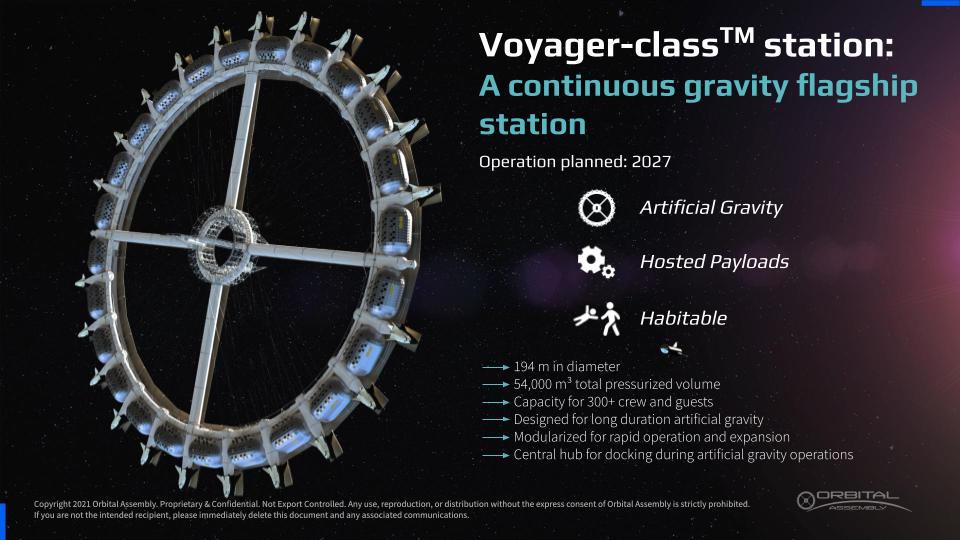
Business Model
OAC aims to fulfill the dream of low-gravity space habitation for all.
While our flagship project will be completion of the first Voyager-class™ Space Station, targeted to be ready in 2027, OAC has identified a number of revenue-generating platforms at every stage of development. Every launch we make to carry equipment and passengers into orbit will be an asset we can commoditize to maximize spacecraft capacity.
In addition to the Voyager-class™ Space Stations, OAC is also developing two space product platforms that we anticipate will offer a multitude of opportunities for positive cash flow by 2025:
Our systems are designed to enable the industrialization and commercialization of space and make possible the following uses including: tourism, media, commerce, industry, and research and manufacturing. We plan for our primary products and services to include:
- Variable Gravity levels
- Pressurized habitat / Multi-purpose areas
- External and Internal payload areas / research facilities, gases, power, etc.
- Reduced risk through advanced safety systems including, emergency return vehicles and areas of refuge.
- Communications systems / local and wide area networks
- Hygiene and systems for human comfort including cold food storage
- Medical facilities
- Robotic arm for manipulation of external payloads and berthing
- Extra-Vehicular Activity space suits
Gravity Ring is slated to become OAC’s first commercial product, which is designed to host payloads from various commercial interests and research institutions. Gravity Ring has the opportunity to pave the way to larger and more capable spacecraft utilizing artificial gravity, such as the Voyager-class™ Space Stations. Many industry partners are already engaged to be part of this historic project, which will address questions about the effects of partial gravity on both living and non-living systems.
Pioneer-class Station, projected to be completed by 2025, feeds forward from Gravity Ring, with the capability to accommodate up to 56 passengers and crew on four to eight habitation modules. This microgravity space station, intended to be used for commercial operations, is designed for intermittent artificial gravity operation, providing the opportunity for long term habatation. The Pioneer-class Station is designed to generate revenue in the following areas: tourism, manufacturing, research, leasing and hosted payloads. OAC anticipates the station will be cash flow positive in its first year of operation, and that its revenue will significantly reduce debt by 2026 so that OAC will be in a good position to fund future construction with minimal equity or debt financing.
Voyager-class Space Stations are OAC’s flagship product, expected to be ready in 2027. They are designed to accommodate more than 300 passengers and crew, including tourists, business travelers, astronauts, scientists, and other groups interested in working and living in space. Designed to offer continuous, near lunar operational artificial gravity, which is similar to the gravitational pull of the moon, as well as microgravity and near continuous sunlight, which will provide ample electrical power. For tourists, we believe we can provide hotel amenities that will include: “space-ous” accommodations; stunning views of the Earth, Moon, and stars; restaurant-quality food and beverages; events; functional toilets and showers; exercise facilities; medical triage services; and emergency evacuation capabilities. We’re not camping in space any more.
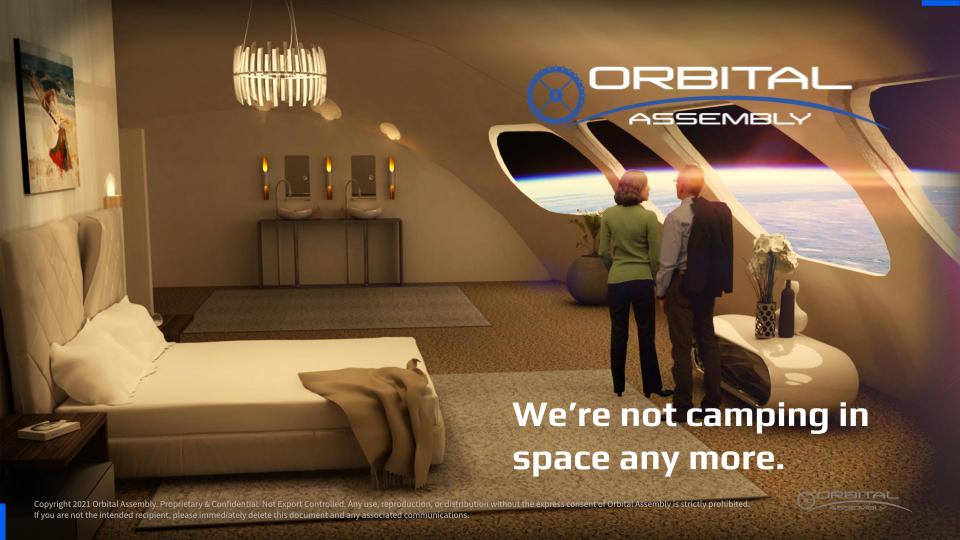
In addition to our proprietary rotating stations, OAC has also developed a proprietary construction system that can be used for a wide range of space construction projects.
DSTAR (Demonstration Structural Truss Assembly Robot™) is an autonomous truss building system machine that assembles large-scale structures (100+ m). Design and structural fabrication of the DSTAR was funded 100% by the company founders and in June of this year, OAC successfully demonstrated the system at our Fontana, California, facility by constructing a six-ton structure the length of a football field in just 24 record breaking minutes. We anticipate the STAR system will amortize its development and operation costs over time as demand builds for its ability to produce superstructure elements for a variety of private industry applications.
The first orbital STAR system [Pioneer Class Structural Truss Assembly Robot, or PSTAR] is designed to work in conjunction with other assembly robots and drones to build space stations, space solar power systems, propellant depots, and other structures. PSTAR can be reused for co-orbital construction projects and projects in the same orbit inclination. It can also be custom built and launched for a specific task or orbit. OAC intends to launch PSTAR in 2023 to build our Gravity Ring spacecraft.
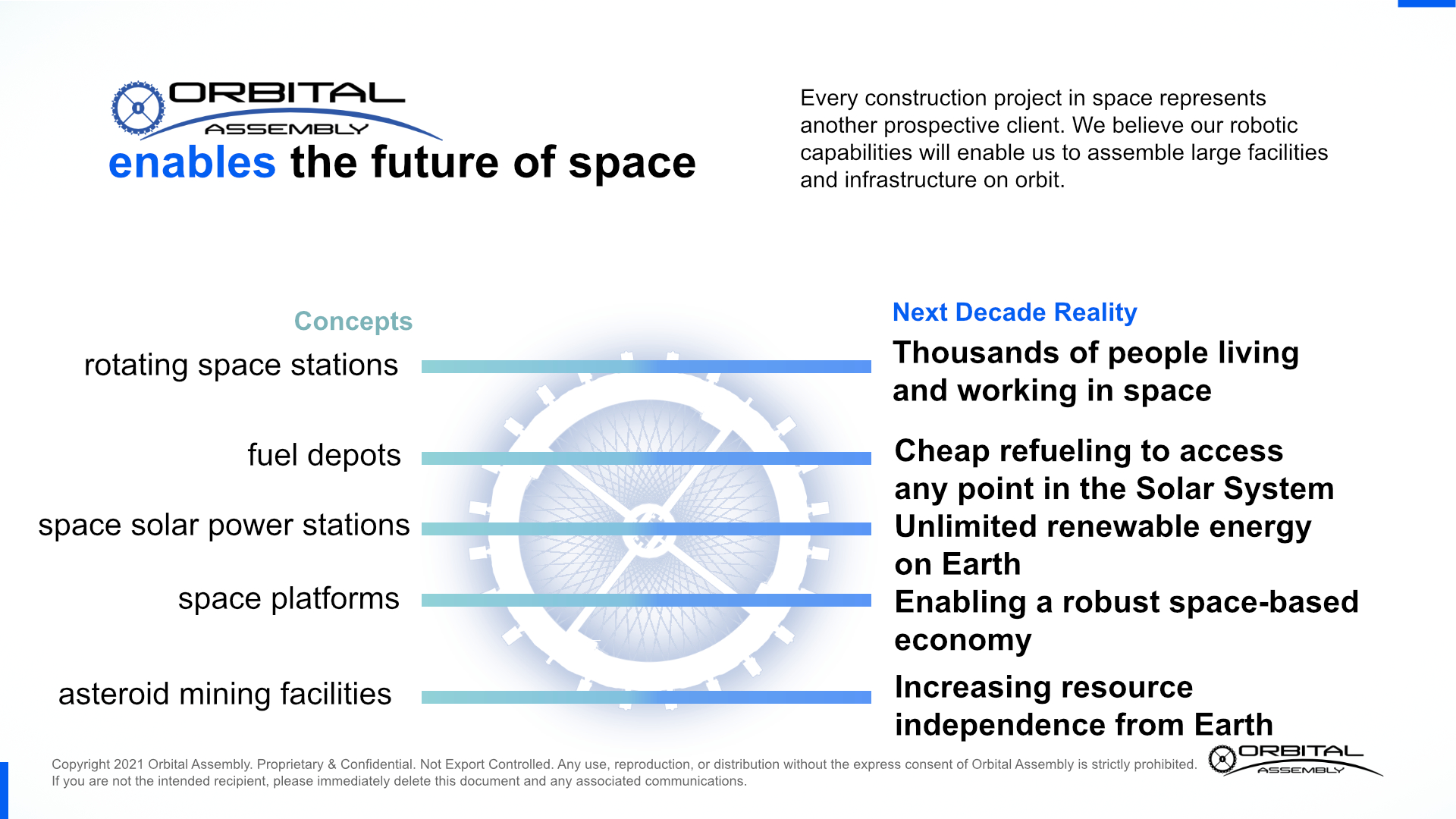
Market
There is a near-term market opportunity of more than $60B/yr. OAC believes we're the first to offer artificial gravity services and we project it will conservatively capture $7.2B/yr in the first year of operation, with its Pioneer-class Station, limited only by station capacity. Greater market share is captured in the larger, more capable facility, Voyager-class Station Mk 1, for which we anticipate construction will begin in 2025. Our revenue projections are broken down into the following components:
- Tourism: $5.6B/yr
- Manufacturing: $880M/yr
- Media, entertainment, and advertising: $320M/yr
- Research (including long duration missions): $260M/yr
- Industrial and commercial development: $110M/yr
- Branding: $10M/yr
Ultimately, OAC is a design based construction and development company. If market factors change, we are well-positioned to shift our focus toward areas with the highest revenue potentials.
These forward-looking statements are not guarantees of future performance and involve a high degree of known and unknown risks, uncertainties, assumptions, and other important factors, many of which are beyond the control of the Company and its management.
Progress
OAC’s world-class management team brings a wealth of space heritage, knowledge, passion, and experience to our organization. The illustrious group includes some of the world’s most experienced engineers, scientists, architects, designers, business professionals, and physicians, whose careers span literally hundreds of years focused on space research, development, innovation and mission success.
Making significant progress in the past two years since forming in 2019, OAC has:
- Launched the DSTAR program with a record breaking successful ground demonstration in June 2021, where the team assembled a structure the length of a football field (78m of truss) in under 25 minutes.
- Achieved significant design progress and initiated advanced design and engineering on the Gravity Ring and PSTAR, projected to launch to sun-synchronous orbit in 2023.
- Coordinated with commercial partners for the design and system testing of the Observer Drone program for late 2021.
- Completed architectural designs for the Voyager-class and Pioneer-class Stations (a free-flying space station based on Voyager station components)
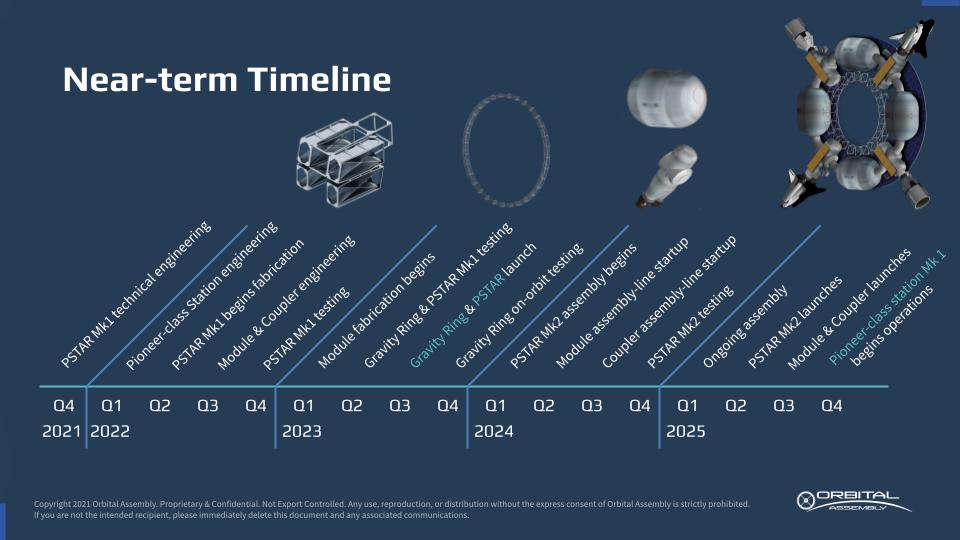
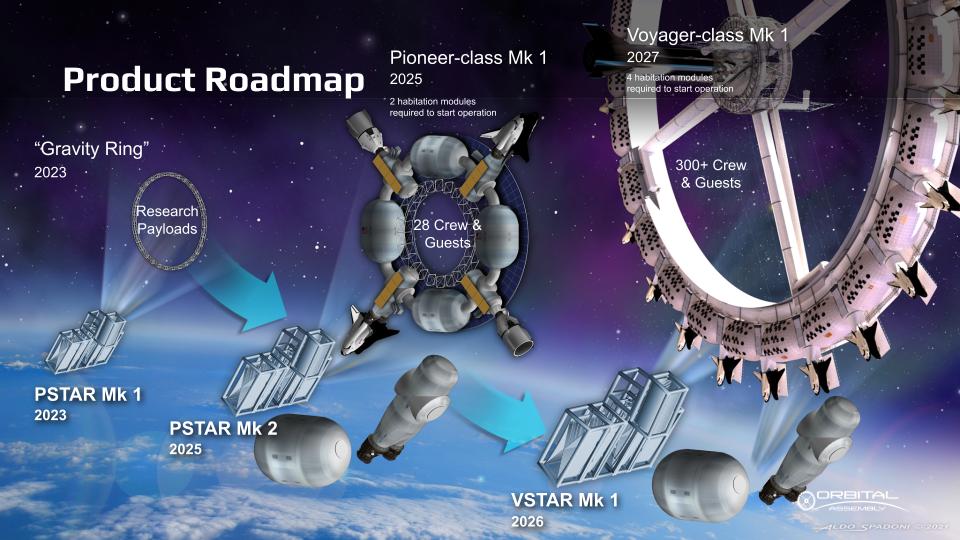
Press
The excitement and anticipation of OAC’s Voyager-class Station has garnered an incredible amount of high-profile publicity, and continues to garner major media interest worldwide. More than 300 stories have appeared to date. These include highly respected broadcast news outlets such as CNN, NPR, and NBC’s The Today Show, as well as national talks shows such as Live with Kelly and Ryan and The Late Show with Steven Colbert. Print coverage includes Architectural Digest, Business Insider, the Robb Report, and BBC News.
Here are a just a few of the links to recent stories and mentions:
Team
OAC has assembled a superb, experienced, passionate team representing hundreds of years of space heritage, with professionals who were instrumental during the earliest days of NASA. Their combined expertise in the fields of construction, commercialization, mission management, design, engineering, physics, space architecture, space craft, space mission design, and business strategically position OAC for success in meeting our financial goals.
As president and chief executive officer, Rhonda Stevenson is leading the team at Orbital Assembly Corporation (OAC) to drive sustainable commercial innovation in the space habitation and construction industry.
Stevenson joined OAC in 2021, after serving as a member of the executive advisory board. She has more than 20 years of business leadership and entrepreneurial experience in the aerospace sector, startups, and franchises, and instills a passion for building successful relationships within the space industry.
Stevenson also heads the non-profit organization ─ Tau Zero Foundation ─ dedicated to pioneering advancements toward interstellar flight, focusing on the intermediate steps of advanced propulsion and energy storage for on orbit capabilities and beyond. She is the creator and host of the “Space Matters” show, a syndicated weekly digest of space industry activities and relevant conversations.
In 2013, Stevenson founded Blue Elysium Enterprises, which provided strategic executive consulting to technology companies. Earlier in her career, she was chief marketing and promotions officer at Deep Space Industries, and founder of Space Mining and Resources Coalition.
Dr. Tom Spilker, a co-founder of Orbital Assembly Corporation (OAC), leads OAC’s space systems development for several projects, including the near-term Gravity Ring and the Voyager Space Station.
Prior to joining OAC, Dr. Spilker consulted on space flight mission architectures and proposals and planetary and solar system science investigations, and provided high-level feasibility assessments and spacecraft system engineering for scientific space flight missions.
He served as both a scientist and engineer at NASA’s Jet Propulsion Laboratory for more than 20 years, including 10 years as a Principal Space Flight Mission Architect. He worked on NASA's Voyager, Cassini, and Genesis missions, and was a co-Investigator for the microwave instrument on the European Space Agency’s Rosetta mission.
Dr. Spilker earned an M.S.E.E and Ph.D.E.E. from Stanford University and a Bachelor of Science degree, summa cum laude, in Geophysics and Computer Science from Kansas State University.
Tim Alatorre NCARB, a founder of Orbital Assembly Corporation, brings more than 20 years of experience in business management, engineering, habitat design, and programming to his roles as chief operating officer and vice president of habitation design.
Alatorre was previously CEO of Domum, an internationally recognized architecture firm based in California. There, he increased revenue by 240% and grew the startup firm to a multinational organization overseeing more than $320 million in construction projects annually. He has supervised the design and construction of more than 600 structures and more than $1.5 billion in construction projects.
Alatorre has served as a planning commissioner and member of a municipal Architectural Review Committee for the city of Rocklin, CA, for several years, and worked as a consulting subject matter expert for the state of California for more than a decade.
Alatorre earned a Bachelor of Architecture degree from California Polytechnic State University in San Luis Obispo.
James Wolff heads business development for Orbital Assembly Corporation, with a focus on developing commercial and strategic partnerships with organizations seeking growth and research opportunities in space. He is also an attorney and entrepreneur, currently developing a corporate portfolio of innovative, cutting-edge startup companies including commercial space, 3D printing technology and robotics.
Wolff is a co-founder of Deep Space Industries, an asteroid mining and space utilities company based at NASA Ames Space Center; CFO of Immortal Data Inc., a space hardware company; and co-founder of Space Initiatives Inc., a company developing advanced femto-sat transponder aerospace hardware.
He is an executive board member-at-large for the United Nations Association, serving on the Southern District Division of New York committee. Wolff received his J.D. from New York Law School and earned a Bachelor of Science degree in Composition from Johns Hopkins University.
As a founding member of Orbital Assembly Corporation, Jeffery Greenblatt plays many roles, including project management, technical analysis, research, cost estimation, market assessment, and fundraising. He currently leads the Pioneer-class Structural Truss Assembly Robot (PSTAR)/Gravity Ring project.
A well-known expert in energy analysis, climate policy and sustainable transportation, he began expanding his focus to emerging space technologies in 2014, and founded Emerging Futures, LLC, an environmental and space consultancy, in 2016.
Prior to that, he served as a staff scientist at Lawrence Berkeley National Laboratory for more than eight years. He has worked in climate and energy research capacities at Google, Environmental Defense Fund, Princeton University and the NASA Ames Research Center.
Greenblatt has a Ph.D. in Chemistry from the University of California, Berkeley, and a Bachelor of Science degree in Physics and Chemistry from Haverford College.
Robert Miyake has more than 60 years of experience as an engineer working in aerospace and space operations. He came out of retirement to join Orbital Assembly Corporation after more than 30 years at the Jet Propulsion Laboratory (JPL), where he was lead thermal systems and systems engineer, working on design, test and flight operations of spacecraft and flight instruments. While there, he worked on NASA missions including, SeaSat, Topex MGS, IAE, WF/PC, and other flight instruments.
Prior to joining JPL in 1978, he worked at Lockheed Missile and Space Company on commercial and military aircraft. He started his career at Boeing Airplane Company in 1961, where he worked on many projects, including the 727 aircraft.
Miyake completed graduate studies in mathematics, bioengineering, system engineering and computer science, and received a Bachelor of Science degree in Mechanical Engineering with a thermal/fluids and nuclear emphasis at San Jose State College.
Eric Ward is an experienced systems engineer and entrepreneur who sees growing the private space industry as the next step to progressing humanity's future by venturing beyond the planet. He has published multiple papers and presentations on system architecture and the space industry, and co-founded and operated several space industry startups.
Ward received a Master of Systems Design and Management degree from Massachusetts Institute of Technology and a Bachelor of Science degree in Mechanical Engineering from Oregon State University. His Erdős number, which is derived from co-authoring mathematical papers, is 4.
Advisors and Investors
Global expert in manufacturing, supply chain management, and fabrication.
Physician, Speaker, Citizen-Scientist Astronaut & Aquanaut, Martial Artist
Chairman of the board of the Tau Zero Foundation
Use of Proceeds
If the offering's maximum amount of $4,000,000 is raised:
| Use | Value | % of Proceeds |
|---|---|---|
| Compensation for managers | $844,865 | 21.1% |
| Payroll (non-managers) | $2,380,670 | 59.5% |
| Facility Lease | $141,446 | 3.5% |
| Recruitment | $50,699 | 1.3% |
| Marketing | $62,867 | 1.6% |
| Admin and Office | $91,766 | 2.3% |
| Travel | $19,519 | 0.5% |
| Legal and Professional Fees | $157,168 | 3.9% |
| Facility Improvements | $55,000 | 1.4% |
| Intermediary fees | $196,000 | 4.9% |
Terms
This number includes all funds raised by the Company in this round on Netcapital. This is an offering of Common Stock, under registration exemption 4(a)(6), in Above: Space Development Corporation dba Orbital Assembly. This offering must reach its target of at least $10,000 by its offering deadline of April 29, 2022 at 9:59pm ET. If this offering does not reach its target by the offering deadline, then your money will be refunded.
If the offering is successful at raising the maximum amount, then the company’s implied valuation after the offering (sometimes called its post-money valuation) will be:
Pitch Deck
Financials
Orbital Assembly’s official name is Above: Space Development Corporation, so that’s the name that appears in the statements below.
These financial statements have been audited by an independent Certified Public Accountant.
SEC Filings
The Offering Statement is a formal description of the company and this transaction. It’s filed with the SEC to comply with the requirements of exemption 4(a)(6) of the Securities Act of 1933.
We’re also required to share links to each of the SEC filings related to this offering with investors.
Understand the Risks
Be sure to understand the risks of this type of investment. No regulatory body (not the SEC, not any state regulator) has passed upon the merits of or given its approval to the securities, the terms of the offering, or the accuracy or completeness of any offering materials or information posted herein. That’s typical for Regulation CF offerings like this one.
Neither Netcapital nor any of its directors, officers, employees, representatives, affiliates, or agents shall have any liability whatsoever arising from any error or incompleteness of fact or opinion in, or lack of care in the preparation or publication of, the materials and communication herein or the terms or valuation of any securities offering.
The information contained herein includes forward-looking statements. These statements relate to future events or to future financial performance, and involve known and unknown risks, uncertainties, and other factors, that may cause actual results to be materially different from any future results, levels of activity, performance, or achievements expressed or implied by these forward-looking statements. You should not place undue reliance on forward-looking statements since they involve known and unknown risks, uncertainties, and other factors, which are, in some cases, beyond the company’s control and which could, and likely will, materially affect actual results, levels of activity, performance, or achievements. Any forward-looking statement reflects the current views with respect to future events and is subject to these and other risks, uncertainties, and assumptions relating to operations, results of operations, growth strategy, and liquidity. No obligation exists to publicly update or revise these forward-looking statements for any reason, or to update the reasons actual results could differ materially from those anticipated in these forward-looking statements, even if new information becomes available in the future.
More Info
Updates
- Jan 24, 2023Orbital Assembly Names Ascent Solar CEO Jeffrey...
- Dec 15, 2022New research study - live now! In partnership...
- Dec 12, 2022New Question and Answer call with CTO, Dr. Tom...
- Dec 9, 2022Orbital Assembly announces a new program and...
- Nov 28, 2022Invitations were just emailed out for our...
- Nov 22, 2022Message for our Investors on the Netcapital...
- Oct 12, 2022# Hello! If you haven't signed up for our email...
- Jul 19, 2022Special video call for our premium...
- May 16, 2022Claim your investor gifts before the July 31st...
- May 10, 2022Tonight between 7:30pm and 8:00pm ET, COO Tim...
- Apr 30, 2022Primary offering finalized, selling shares
- Apr 26, 2022The OAC Executive team would like to extend our...
- Apr 19, 2022It is with great excitement that we welcome...
- Apr 12, 2022We are excited to announce our partnership with...
- Apr 8, 2022We have launched a new show, "Our Future In...
- Apr 6, 2022In case you missed it. New Q&A with COO Tim...
- Mar 25, 2022Last week we emailed you about our first ever...
- Mar 23, 2022Orbital Assembly Corporation is relocating its...
- Mar 22, 2022Orbital Assembly Congratulates Chief of Medical...
- Mar 18, 2022Orbital Assembly has launched our first ever...
- Mar 11, 2022Orbital Assembly's COO, Tim Alatorre, did a...
- Feb 4, 2022Did you know? In the summer of 2021 we...
- Feb 2, 2022In the last 12 months OAC has had 2 successful...
- Jan 31, 2022OAC is constantly in the news. We want to keep...
- Jan 28, 2022Greetings: Here is the second of the two-part...
- Jan 26, 2022Greetings: We wanted to share the first of a...
- Jan 24, 2022We are nearing $1M in our second raise and...
- Jan 13, 2022OAC is pleased to be featured on e360tv this...
- Jan 11, 2022Dear OAC supporters: Many of you have already...
- Nov 30, 2021# We are excited to announce passed...
- Nov 9, 2021If you are an investor we would love to say...
- May 25, 2021Orbital Assembly Corporation is excited to...
- Apr 22, 2021Primary offering finalized, selling shares
- Jan 29, 2021Today we will be holding a virtual event at 1pm...
Ask a Question
Proofread your comment before submitting: once it's posted, you can’t edit or delete it. Investors are advised to review our Discussion Board Policy before submitting a comment. For the fastest help with the web site, email help@netcapital.com instead of commenting.
Looking to raise capital?
We can help turn your friends, family and customers into investors.
Interested in more investment opportunities?
Browse all offerings currently available.



